Anna’s Hummingbird
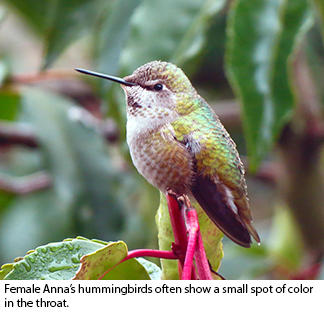 The Anna’s Hummingbird is one of the most intensely-studied species of hummingbirds, but many questions remain to be answered, particularly about post-breeding movements and range expansion. Just 80-100 years ago they were a species confined to Baja California and along the California coast as far north as San Francisco. For unknown reasons, in the 1930s they began to expand their range northward, and have now reached southern British Columbia and the tip of southern Alaska, and have started an eastward expansion as well. It is thought that the prevalence of feeders has aided their ability to remain in many of these areas, but feeders are not responsible for the expansion or for them remaining in an area once they have established a population. The plating of exotic flowers and the expansion of urban/suburban areas is also considered important for these birds.
The Anna’s Hummingbird is one of the most intensely-studied species of hummingbirds, but many questions remain to be answered, particularly about post-breeding movements and range expansion. Just 80-100 years ago they were a species confined to Baja California and along the California coast as far north as San Francisco. For unknown reasons, in the 1930s they began to expand their range northward, and have now reached southern British Columbia and the tip of southern Alaska, and have started an eastward expansion as well. It is thought that the prevalence of feeders has aided their ability to remain in many of these areas, but feeders are not responsible for the expansion or for them remaining in an area once they have established a population. The plating of exotic flowers and the expansion of urban/suburban areas is also considered important for these birds.
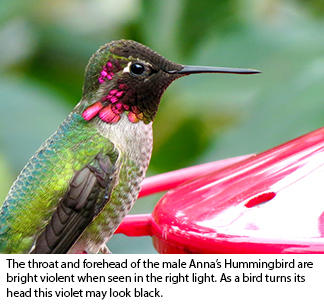 Male Anna’s Hummingbirds have a purplish-red forehead and throat. The throat feathers are broad and often extend beyond the throat across the upper neck. Females usually have a spot of color on the throat. Like other hummingbirds, no pair-bond is ever established. Males defend a territory from other males and display to attract a female. The territory is often where they find a female staying in an area. Males may fly up to a height of 110 feet or more, then dive, making noise with their wings as they pull up from the bottom of the dive. This display is usually to attract a potential mate but may also be used to deter or intimidate other males. As a male sits in the open he turns his head so his throat can be turned also, which causes flashes of color aimed at a female whose attention he wishes to attract. Males also sing a complex, learned song, which is unusual for non-passerine birds (non songbirds).
Male Anna’s Hummingbirds have a purplish-red forehead and throat. The throat feathers are broad and often extend beyond the throat across the upper neck. Females usually have a spot of color on the throat. Like other hummingbirds, no pair-bond is ever established. Males defend a territory from other males and display to attract a female. The territory is often where they find a female staying in an area. Males may fly up to a height of 110 feet or more, then dive, making noise with their wings as they pull up from the bottom of the dive. This display is usually to attract a potential mate but may also be used to deter or intimidate other males. As a male sits in the open he turns his head so his throat can be turned also, which causes flashes of color aimed at a female whose attention he wishes to attract. Males also sing a complex, learned song, which is unusual for non-passerine birds (non songbirds).
Feeders Cannot Prevent Migration
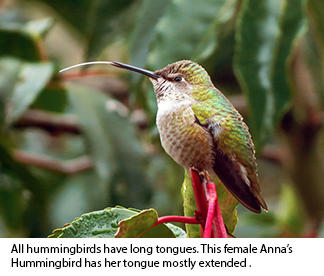 Back to our original premise: the reasons for moving into new areas or remaining, once established, cannot be so simplistic as just feeders and exotic flowers. When range expansion first began, very few people were feeding birds of any kind. It has only been in recent years that hummingbird feeders have become popular, so they cannot be the reason this species has changed its range. Once the range has expanded, feeders are helpful, but they, and exotic flowers, are not the reason that the birds began to arrive in new regions. The hummingbirds have no way of detecting feeders or flowers in advance of an area they expand to. They may utilize them once they find them, but they cannot know what may be present in a new region.
Back to our original premise: the reasons for moving into new areas or remaining, once established, cannot be so simplistic as just feeders and exotic flowers. When range expansion first began, very few people were feeding birds of any kind. It has only been in recent years that hummingbird feeders have become popular, so they cannot be the reason this species has changed its range. Once the range has expanded, feeders are helpful, but they, and exotic flowers, are not the reason that the birds began to arrive in new regions. The hummingbirds have no way of detecting feeders or flowers in advance of an area they expand to. They may utilize them once they find them, but they cannot know what may be present in a new region.
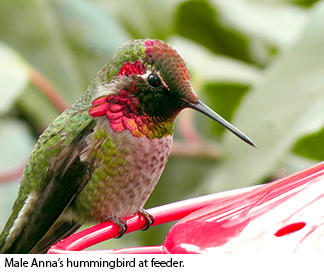 If the presence of food at feeders could keep Anna’s Hummingbirds from migrating, then why don’t they prevent Rufous Hummingbirds from migrating from areas such as the Willamette Valley? Rufous Hummingbirds leave the area in early to mid-summer, and there are plenty of feeders available and many flowers still in bloom. In addition, why do Ruby-throated Hummingbirds in the East continue to migrate when there are many people feeding them? Many neotropical migrants fly to North America for breeding, yet the region they left still has plenty of food for them. It makes no sense that only Anna’s Hummingbirds could be kept from migrating when all other species are not affected. Captive migratory birds of many species become restless when the normal time of migration arrives. Studies with captive birds often show them restless and orienting toward the side of their enclosure that is in the direction of their migratory route. These are well-fed birds, but they want to go, to continue on a journey they feel compelled to head towards.
If the presence of food at feeders could keep Anna’s Hummingbirds from migrating, then why don’t they prevent Rufous Hummingbirds from migrating from areas such as the Willamette Valley? Rufous Hummingbirds leave the area in early to mid-summer, and there are plenty of feeders available and many flowers still in bloom. In addition, why do Ruby-throated Hummingbirds in the East continue to migrate when there are many people feeding them? Many neotropical migrants fly to North America for breeding, yet the region they left still has plenty of food for them. It makes no sense that only Anna’s Hummingbirds could be kept from migrating when all other species are not affected. Captive migratory birds of many species become restless when the normal time of migration arrives. Studies with captive birds often show them restless and orienting toward the side of their enclosure that is in the direction of their migratory route. These are well-fed birds, but they want to go, to continue on a journey they feel compelled to head towards.
In fact, I often argue that if feeders did affect migration, their presence would actually encourage rather than delay migration. Consider the natural behavior of Rufous Hummingbirds. In Western Oregon, they arrive in early to mid-February and soon begin to breed. They will typically have two broods or more. By mid-summer most of these hummingbirds will have left the lowlands and have moved to mountain meadows. Some juveniles may remain, but most adults are gone. Once in the mountains they begin to feed on the wildflowers blooming there. The sugar in the nectar of these flowers is converted to fat that is stored for use as fuel for migration. When they have doubled their weight with fat deposits, they soon leave for their winter habitats. If there are many flowers, it is easier to obtain the needed sugar and build the fat needed. Usually, this can happen in just a couple of weeks and then they leave. But, if there are fewer flowers, the birds must spend more time searching, burning some of the fat that should be stored. As a result, migration is delayed. So, if feeders did play a role (they don’t) with many feeders available, the birds could build their fat reserves faster and leave earlier. If no feeders were available, it should delay migration while the birds seek other foods to help them. So, please leave your feeders up so that you can enjoy any Anna’s Hummingbirds that visit during the winter.
Hummingbirds cannot survive on just the nectar from flowers or feeders. They need additional proteins and minerals. These foods are easily obtained by the hummingbird through their natural foraging. Such added proteins and minerals would be difficult for you to add small-enough quantities to be safe in your artificial nectar. Some commercially-available “nectars” provide such added nutrients, but I recommend against using such solutions. The hummingbirds easily obtain all they need and providing them in your nectar simply overloads these small bodies. In addition, since no research has proven such additives to be safe, why risk harm to these tiny birds!? The amounts of chemical nutrients in these so-called nectars could easily be far too great for the hummingbirds to benefit from and it could harm them. It is best to provide only sugar. A completely adequate amount of proteins and minerals are obtained by eating insects and small spiders.
Studies of captive hummingbirds have shown that Anna’s Hummingbirds can survive for 10 days if fed just sugar. After that, their system needs additional nutritional materials or they cannot survive. So, spending the winter using only feeders people put out would be impossible. As temperatures begin to drop in winter though, feeders become an easier source of food requiring less need to search out food and thus, the birds expend less energy in the process. Insects, spiders and their egg masses are easily available to the hummingbird at all times of year and provide the bulk of a hummingbird’s diet. Your feeder may account for 12-15% of their diet and possibly up to 20% in extreme cold weather but the rest of the diet is through natural food sources.
Migration and Range Expansion
Another reason that feeders can play no role in migratory behavior in Anna’s Hummingbirds is because this species is essentially non-migratory. No seasonal latitudinal movement is known for these hummingbirds, unlike all other hummingbirds north of Mexico. We know that there is a post-breeding dispersal that occurs with many populations, but where and if this occurs it differs from population to population, such as the Willamette Valley population, or the Northern California population. Some birds move to higher elevation and some move east from western portions of their range. In northern populations, there are no studies that tell us about movements throughout the year. Is the bird raising young in your area in March or April the same bird you see at a feeder in December? It may be the case, but there is no way to know for sure. Since there is no fixed pattern of migration and since the birds are seen throughout the year in most of their range, the species is considered non-migratory and no true migration pattern has yet been documented.
Range expansion is very different from migration.
While migration is a fixed pattern, range expansion may be sporadic and may occur over many generations. In some bird species, range expansion may occur as a result of habitat destruction and birds must simply find new suitable habitats to move into to sustain themselves. For other species, like Red-shouldered Hawk, White-tailed Kite, Black Phoebe and others, climate change may be a factor, although not necessarily the single cause of the expansion. In many other species there may be no readily apparent answer that we can point to as a possible cause of expansion. This is the case for Anna’s Hummingbird. We don’t know why these birds began moving north and east in the 1930s, but once started, they have continued their expansion. Once breeding is complete, many birds disperse and it is during this dispersal period that they may begin finding new areas in which to settle.
Anna’s Hummingbirds are not forest dwellers so as they expand they look for open regions and the ever-increasing suburban neighborhoods make perfect places to move into. If feeders and exotic flowers are available, all the easier it is to settle in. Flowers are always preferred over feeders if the birds are given a choice. As previously stated, feeders do not prevent migration. The potential negative aspects of feeders can be increased vulnerability to cats if placement of feeders is not carefully considered, and a potential health risk to the birds if people allow the nectar in their feeders to grow mold or bacteria, or if people have erroneously supplied a nectar not made of sucrose (table sugar).
Nectar and Other Food Sources
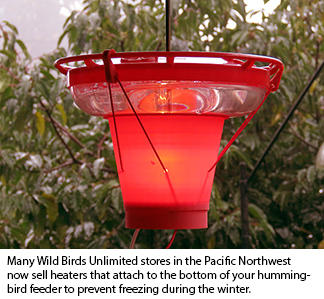 As we all know, nectar is an important food source for hummingbirds, but other foods, primarily small insects and spiders, must also be eaten to obtain the necessary proteins and other minerals. The sugar found in flower nectar is sucrose, the same sugar that is our table sugar. If presented with a choice of sugars (sucrose, fructose, glucose, maltose, galactose) at the same concentrations, the hummingbirds will always feed on the sucrose and abandon the others. This is probably because flower nectars are almost pure sucrose. There may be trace minerals or proteins, but they are at such a low level that the birds derive no nutritional value from anything but the sugar.
As we all know, nectar is an important food source for hummingbirds, but other foods, primarily small insects and spiders, must also be eaten to obtain the necessary proteins and other minerals. The sugar found in flower nectar is sucrose, the same sugar that is our table sugar. If presented with a choice of sugars (sucrose, fructose, glucose, maltose, galactose) at the same concentrations, the hummingbirds will always feed on the sucrose and abandon the others. This is probably because flower nectars are almost pure sucrose. There may be trace minerals or proteins, but they are at such a low level that the birds derive no nutritional value from anything but the sugar.
When making nectar for your hummingbird feeder, it is always recommended that you use a ratio of 1 part sugar to 4 parts water, a 25% solution. In nature, Anna’s Hummingbirds usually feed on flowers with less sweet nectar. One study observed which species of flowers were most preferred by Anna’s Hummingbirds. Afterwards, the sugar concentration of each type of flower was determined. The average concentration of sugar was found to be 21%, or closer to a ratio of 1:5, significantly less sweet than the 1:4 recommended for your feeder.
Some other hummingbirds, like Rufous Hummingbird, like sweeter nectars than Anna’s Hummingbirds do.
Some people have the mistaken idea that you should provide a sweeter nectar in winter, using a ratio of 1:3, or worse, even higher. Their belief is that this helps the hummingbirds get more energy. This is NOT the case, so please DO NOT make your nectar more concentrated than 1:4! The hummingbird can only absorb and metabolize sugar at a certain rate. Adding more sugar will not increase that ability. More importantly, as the sugar level increases, the level of dehydration of the bird’s tissues also increases, causing thirst and stress, and if the sugar concentration is too high, diarrhea may result putting the bird at extreme risk for water loss or potential death. With higher sugar levels, the birds may visit feeders more frequently, but this is not to feed. They visit because the high sugar content has made them thirsty. The more they drink, the thirstier they get. The winter’s cold is already a stress so don’t add additional stress by making your nectar too concentrated.
The sugar you should use to make hummingbird nectar should ONLY be pure, white table sugar. This is highly refined and is nearly 99.9% pure sucrose—exactly what you would find in a hummingbird flower. Don’t use most organic sugars. While organically grown is not a problem in itself, typically, these products are not as highly refined and carry small contaminants that are of no consequence to us. But, hummingbirds have very tiny bodies compared to us so these substances can be problematic for them. Additionally, note that most organic sugar has a slightly tan color, not the pure white of standard table sugar. This tan color is caused by molasses, which hummingbirds cannot digest. These organic products are great for us, but keep a bag of pure, white table sugar for the hummingbirds. It is their most natural food.
Other sugars should NEVER be used. Most other sugars are not liked by hummingbirds and some they cannot digest. Honey is to be avoided at all costs. Honey is produced by bees and not a substance any hummingbird will ever feed on in nature. It contains a complex of many sugars, some that cannot be digested by hummingbirds, and it often can carry fungal spores that can infect the tongue and gullet of hummingbirds. If you ever see a hummingbird unable to retract its tongue into its beak, it is likely that if fed from a feeder containing honey. The fungus growing from the spores in the honey make it impossible for the bird to withdraw its tongue and it will soon starve to death.
It is a popular idea that red is necessary to attract hummingbirds and so red dye is often used when making nectar. Red is NOT necessary and red dye may put the birds at risk. Some manufacturers of artificial nectar still add red dye and claim that no studies show any harm to hummingbirds. However, there are good studies done in Japan with mice that show red dye can cause cancer. Mice fed the dye will often grow colon tumors. Hummingbirds are of similar size and physiology and it is highly likely that the dye would also cause tumor formation in hummingbirds. It is true that no study has been done, but why put hummingbirds at risk when we know the probable outcome?
The idea of putting red dye in nectar comes from the fact that flowers which have evolved to attract hummingbirds are typically red. Hummingbirds see all colors well, but red stands out well against green foliage making it easy for the birds to see. Hummingbirds will certainly go to other colors of flowers in search of nectar and insects. The wild tall Larkspur is dark blue, but is frequently visited by hummingbirds, for example. Red also works for the flowers that selectively attract hummingbirds because insects don’t see red well and are not attracted to it. (The yellow “flower” inserts used in many brands of hummingbird feeders will attract insects as well.) Since hummingbirds have little or no sense of smell, hummingbird flowers have no odor with which to attract insects. Additionally, many flowers are tubular, a shape allowing the hummingbird access but denying many insects entry, plus they point downward with the opening of the tube below. Hummingbirds will hover and probe their beak up into a flower, but probing insects, like butterflies, prefer not to hang upside-down to feed and they ignore these flowers.
Anna’s Hummingbirds are easy to attract to your yard, but there are some considerations you need to pay attention to. These birds have a very specific feeding route that they follow each day, visiting the flowers and feeders. But, they also explore in nearby areas from their route, because flowers will of course die back and new sources of food must be sought. It is during these explorations that they may find your feeder and include it in their daily route. This means that if you hang a new feeder, it may take a while for the birds to first find it. If you put out a new feeder be sure to keep it full of fresh nectar even if no birds come for a while. You want to be sure that when the birds do discover your feeder it has good, fresh food in it, so they will wish to return again and again. Sugar-water can spoil rapidly, especially in warm weather so keep the feeder replenished with fresh nectar every few days so that the birds will want to continue to come and will not be put at risk if they do come. You don’t want to ever have nectar that is moldy! If it looks cloudy, that means that bacteria is rapidly growing in the nectar and it must be changed. During the winter a weekly change is all that is usually necessary, but in the summer, you may need to change the feeder daily or at least every 2 days. At WBU a product called Nectar Defender can be purchased. If you follow the directions on the bottle this product is safe to use. Unlike most commercial additives, this product has been very thoroughly tested and by independent sources. Cornell Lab of Ornithology does not recommend that you ever put any additives in your nectar, but has approved this product. It extends the life of your nectar for several days by adding copper at a level that inhibits molds and bacteria but does not contain a level toxic to birds. The amount of copper in this product is less than obtained by hummingbirds eating insects.
You will be very rewarded once you have attracted Anna’s Hummingbirds into your yard, too. They are beautiful and full of fun behaviors to observe. They are fearless, often chasing off birds much larger than themselves and they will approach quite closely, often coming to your feeder to drink even if you are standing next to the feeder. Just be sure to keep the feeder full of fresh nectar all year long as the birds will want to come at all months. They will move elsewhere if you remove the feeder for long periods of time. It can be especially rewarding to have these wonderful birds coming even in mid-winter.

